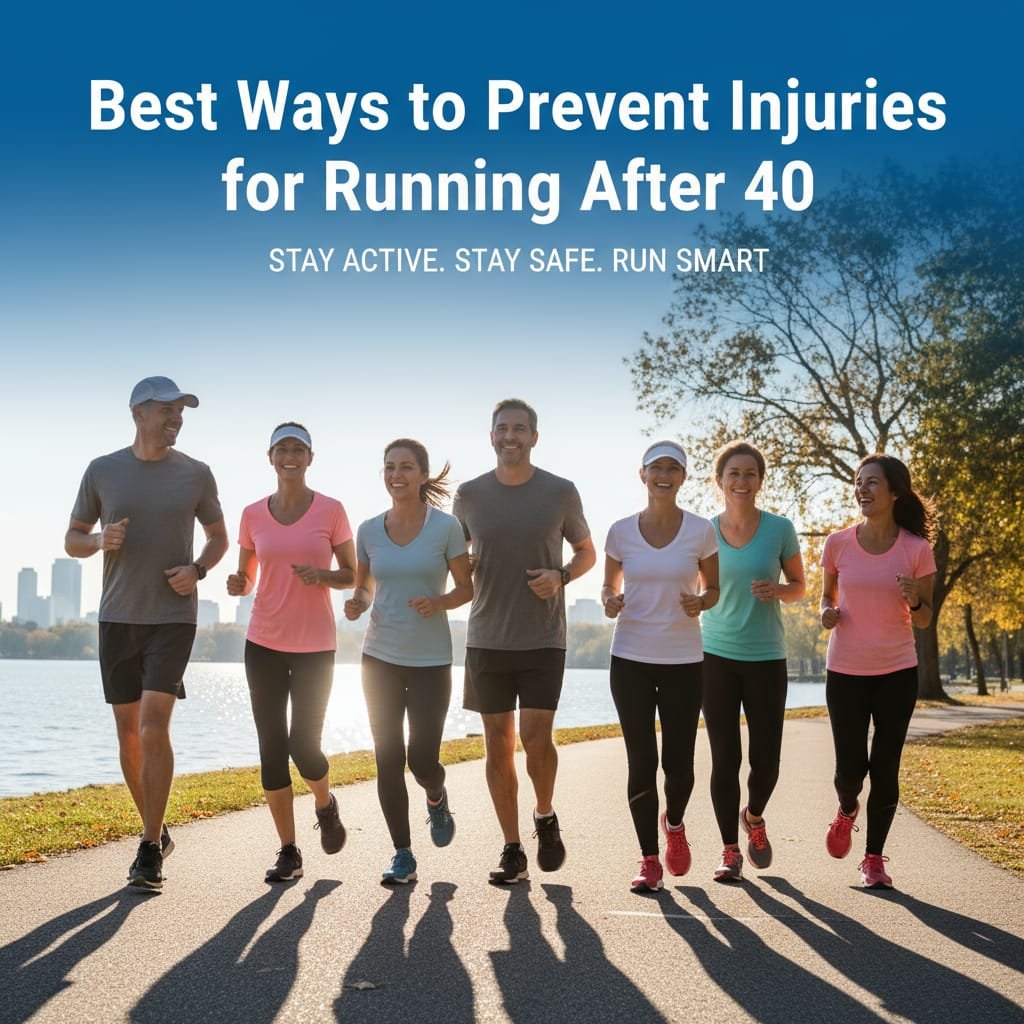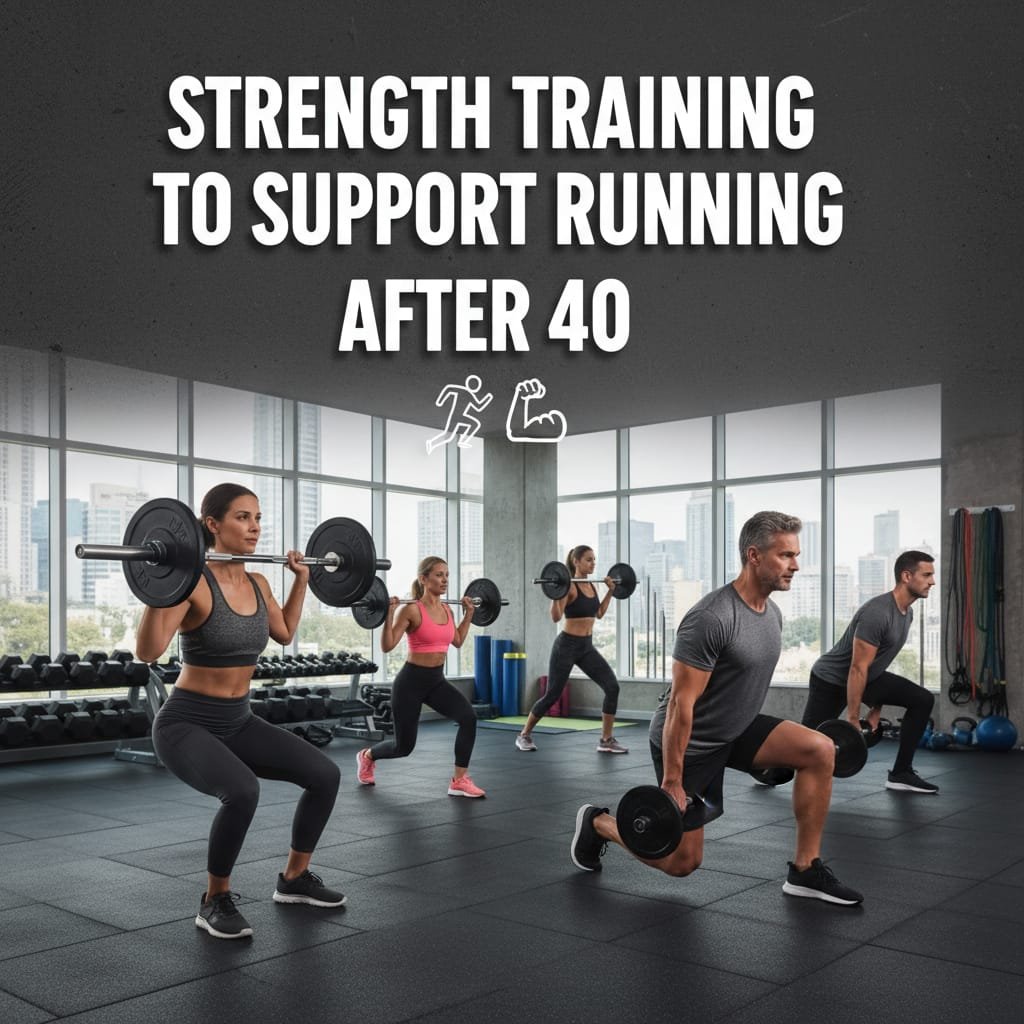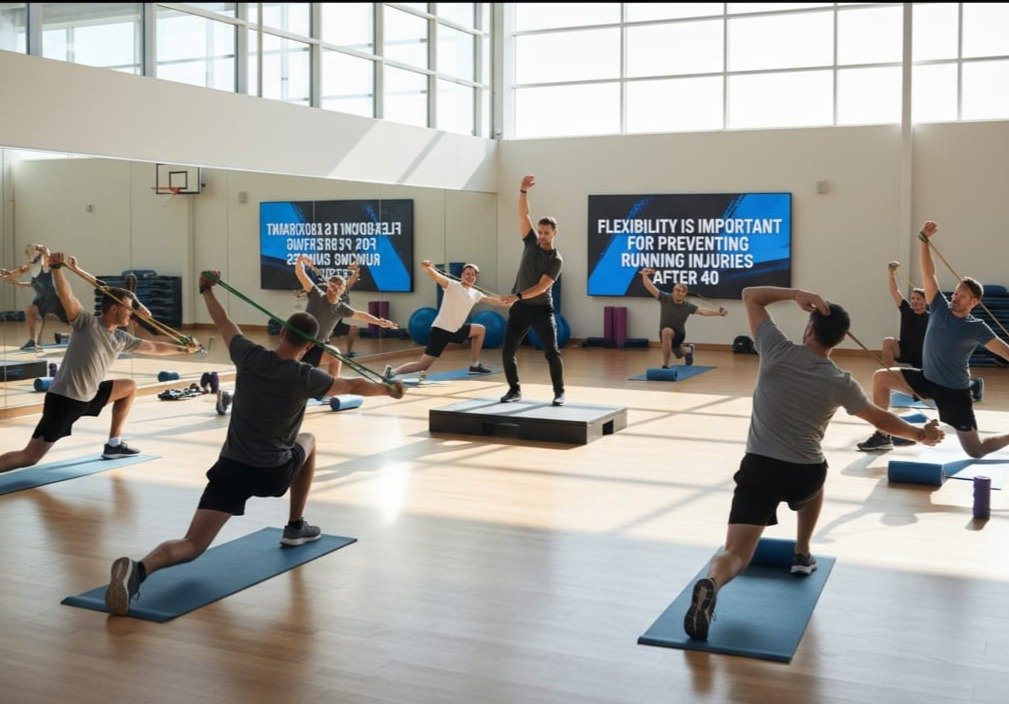Running after 40 can feel like a leap of faith, especially because injury fears loom large. It’s true: many midlife runners pause or even quit due to setbacks. Some bounce back with rehab and grit, while others quietly step away. But what if injury wasn’t inevitable? What if you had the tools to run smarter, recover faster, and stay strong for the long haul? Let’s break down the strategies that keep midlife runners moving – safely, consistently, and joyfully.

Warm-Ups And Cool-Downs: Non-Negotiable For Running After 40
Running after 40 demands more than motivation – it calls for strategic care. Your joints, muscles, and connective tissues thrive when you prepare them with intention before your run and release tension thoughtfully afterward. This isn’t just about avoiding injury – it’s about building a body that supports your passion for the long haul.
Warm-Up Essentials
Begin with dynamic stretches and light cardio drills – leg swings, arm circles, knee raises. These movements increase blood flow, activate key muscle groups, and improve flexibility, helping you sidestep strains and sprains before they start.
Cool-Down Musts
After the run, ease into a short walk, then shift into static stretches (like hamstring holds) and slow dynamic movements. This sequence regulates your breathing, releases tension, and prevents stiffness, essential for recovery and long-term resilience.
Progress Gradually with Running After 40 To Avoid Injuries:
Ambition is powerful, but after 40, your body needs time to catch up with your goals. Rapid increases in mileage or speed can overwhelm your joints, tendons, and connective tissues, leading to overuse injuries that sideline your progress.
Instead, adopt a gradual, strategic approach. Increase your mileage by no more than 10%, and give your body time to adapt to new demands. This isn’t about playing it safe – it’s about staying in the game long enough to thrive.
Running After 40: Choose the Shoes That Protect Your Strides
Your running shoes aren’t just gear – they’re your frontline defense against impact-related injuries. As we age, joints and connective tissues lose some of their natural resilience. That’s why choosing the right footwear becomes essential after 40.
Look for running shoes that offer:
- Structured support for ankles and arches
- Roomy toe boxes for natural toe splay
- Shock-absorbing soles to reduce ground strike impact
- Breathable uppers to prevent overheating and blisters
- Moisture-wicking liners to keep feet dry and prevent soggy socks
- Lightweight design to reduce fatigue over longer runs
- Durable outsoles with good traction for varied terrain
- Heel counters that stabilize your foot and reduce wobble
The right shoes can dramatically lower your risk of running injuries such as runner’s knee, plantar fasciitis, Achilles tendinopathy, and stress fractures. If you’re running after 40, your footwear should work as hard as you do – preserving your joints, protecting your stride, and keeping you moving strong.
Running After 40 Needs Strength Training to Stay Injury-Free
As we age, our muscle mass naturally declines – a natural process known as sarcopenia. If left unchecked, it leads to compromised form, slower recovery, chronic soreness, and increased fatigue. For runners over 40, that’s a setup for injury. The antidote? Strength training at least 2–3 times per week.
Focus on exercises that target major muscle groups:
- Core for postural control and pelvic stability
- Quadriceps and hamstrings for stride power and knee protection
- Glutes and calves for propulsion and shock absorption
- Upper body – back, shoulders, chest, and arms. Upper body strength is vital for maintaining posture, arm drive, and balance while running.
Strong muscles stabilize your joints, improve running efficiency, and reduce injury risk. A well-structured strength plan isn’t just helpful – it’s the foundation for sustainable running after 40.

Sleep: The Most Overlooked Injury Prevention Strategy for Runners Over 40
You can log miles, lift weights, and stretch with precision, but without proper sleep, your recovery falls apart. Muscle repair, hormone regulation, and tissue regeneration all happen during deep sleep. Those microtears in your muscles? They’re also stitched together while you sleep.
Sleep deprivation disrupts this process, increasing your risk of injury, fatigue, and poor post-run recovery. For runners over 40, that’s a recipe for burnout. Aim for at least 7-8 hours of quality sleep each night. And don’t underestimate the power of a recovery nap – just a 30–60 minutes post-run nap can reduce soreness, restore energy, and support long-term resilience.
Listen to Your Body
Your body is your most honest coach. Persistent pain, lingering soreness, or unusual fatigue aren’t just inconveniences – they’re warning signs. Ignoring them can turn minor issues into major injury setbacks.
Learn to distinguish between the pain that builds you and the pain that signals injury, technical flaws, or coordination errors. Productive pain fades with proper recovery – hydration, sleep, and rest. But pain that lingers is a red flag. Don’t push through it. Address it first.
Pay close attention to how your body responds during and after each run. If discomfort persists, adjust your training plan, scale back on intensity, or swap a session for active recovery. And if symptoms linger, consult a healthcare professional before they escalate.
Running smart means running aware. Your body knows the difference, and it will keep sending signals. Your job is to listen.
Cross-Train to Avoid Injuries and Build Balanced Fitness
Running builds endurance, cardiovascular strength, and lower-body power—but it’s mostly forward motion. It doesn’t challenge your body laterally or backward, and it underutilizes the upper body. Over time, this can create muscular imbalances and increase the risk of overuse injuries.
The solution? Cross-training.
Incorporate activities that activate underused muscle groups and movement patterns:
- Swimming for joint-friendly resistance and full-body coordination
- Yoga for flexibility, core strength, and breath control
- Racquet sports like badminton or ping pong to train lateral and backward movement
- Strength circuits to reinforce upper-body engagement and postural control
Cross-training builds a more resilient, adaptable body. It adds variety, prevents monotony, and reduces strain on overworked muscle groups—keeping your fitness well-rounded and injury-resistant.
Hydration and nourishment:
Hydration and nutrition are your performance anchors. As the body ages, its ability to regulate fluids and recover from exertion becomes less efficient. That’s why midlife runners must fuel and rehydrate with intention.
Dehydration increases the risk of cramps, muscle strains, and sluggish recovery. Poor nutrition weakens tissue repair, amplifies fatigue, and slows post-run healing.
To stay strong and injury-resistant:
- Prioritize protein (1.2–1.6g/kg body weight) to support muscle repair.
- Replenish electrolytes after long or sweaty runs.
- Drink water during training and throughout the day, and not just when you feel thirsty.
- Choose whole foods rich in antioxidants, omega-3s, and complex carbs to support joint health and energy
Recovery starts with what’s on your plate and in your bottle. Nourish your body, hydrate your stride, and it will reward you with strength, resilience, and better performance.
Flexibility: The Unsung Hero of Injury Prevention
Flexibility gives your muscles and joints the range they need to move efficiently and absorb impact. As we age, tendons and ligaments lose elasticity, and muscles shorten, making us more prone to strains, stiffness, and compensation injuries.
Regular flexibility work helps:
- Improve stride length and joint mobility
- Reduce muscular tension and post-run soreness
- Prevent imbalances that lead to overuse injuries
Incorporate dynamic stretches before your run and static stretches afterward. Add mobility drills and yoga sessions weekly to expand the end range of motion in your hips, knees, ankles, and shoulders. Relaxed, elongated muscles move with ease, recover faster, and protect your body from breakdown.

Final words:
I’ve faced my share of running injuries, mostly because I didn’t know the prevention strategies I’ve shared here. But I was determined to heal, rebuild, and return stronger. You don’t have to learn the hard way. Every strategy in this post matters – some may seem minor, but together they form the foundation of injury-free, sustainable running.
Stick to the basics. Stay consistent. Listen to your body and commit to the kind of training that supports you – not just today, but every time you lace up. Your stride can be strong, joyful, and resilient. Let it be built on knowledge, not setbacks.
Explore more midlife running tips, injury prevention strategies, and strength-building insights at NadyFitness.com – where every stride is backed by science, experience, and heart.